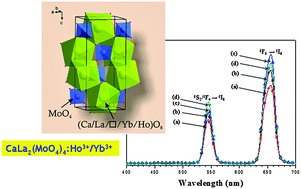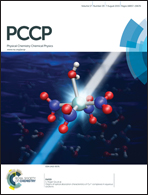The modulated structure and frequency upconversion properties of CaLa2(MoO4)4:Ho3+/Yb3+ phosphors prepared by microwave synthesis†
Abstract
CaLa2−x(MoO4)4:Ho3+/Yb3+ phosphors with the doping concentrations of Ho3+ and Yb3+ (x = Ho3+ + Yb3+, Ho3+ = 0.05; Yb3+ = 0.35, 0.40, 0.45 and 0.50) have been successfully synthesized by the microwave sol–gel method. The modulated and averaged crystal structures of CaLa2−x(MoO4)4:Ho3+/Yb3+ molybdates have been found by the Rietveld method, and the upconversion photoluminescence properties have been investigated. The synthesized particles, being formed after the heat-treatment at 900 °C for 16 h, showed a highly crystallized state. Under the excitation at 980 nm, CaLa2−x(MoO4)4:Ho3+/Yb3+ particles exhibited strong 545 and 655 nm emission bands in the green and red regions. When the Yb3+ : Ho3+ ratios are 9 : 1 and 10 : 1, the UC intensity of CaLa1.5(MoO4)4:Yb0.45/Ho0.05 and CaLa1.45(MoO4)4:Yb0.50/Ho0.05 particles is the highest for different bands. The CIE coordinates calculated for CaLa2−x(MoO4)4:Ho3+/Yb3+ phosphors are related to the yellow color field. The Raman spectrum of undoped CaLa2(MoO4)4 has revealed about 13 narrow lines. The strongest band observed at 906 cm−1 was assigned to the ν1 symmetric stretching vibration of MoO4 tetrahedra. The spectra of the samples doped with Ho and Yb, as obtained under the 514.5 nm excitation, were dominated by Ho3+ luminescence over the wavenumber range of >700 cm−1 preventing the recording of the Raman spectra.


 Please wait while we load your content...
Please wait while we load your content...